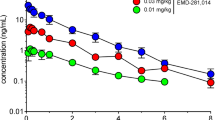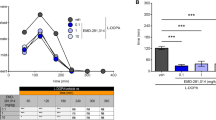Abstract
Drug-induced dyskinesia is a major complication of dopamine replacement therapy in advanced Parkinson’s disease consisting of dystonia, chorea and athetosis. Agonists at 5-HT1A-receptors attenuate levodopa-induced motor complications in non-human primates. Mice with increased dopamine D2 receptor (DRD2) signalling due to the lack of expression of the regulator of G-protein signalling 9 (RGS9) also develop dyskinesia following levodopa treatment. We investigated whether the 5-HT1A-receptor agonist flibanserin compared with buspirone reduces motor abnormalities induced by levodopa or quinelorane, a selective dopamine D2-receptor agonist. Following dopamine depletion via reserpine, 40 mice (20 wild-type and 20 RGS9 knock-out) were treated with flibanserin or buspirone in combination with levodopa or quinelorane. Motor behaviour was analysed using open field analysis. RGS9 knock-out mice displayed significantly more drug-induced dystonia (p < 0.04; t test) than wild type. In quinelorane-treated wild-type mice flibanserin as well as buspirone significantly reduced dystonia (p < 0.05). In RGS9 knock-out animals again both reduced quinelorane-induced dystonia. However, flibanserin was significantly more effective (p = 0.003). Following reserpine pretreatment and administration of levodopa wild-type and RGS 9 knock-out mice showed mild to moderate dystonia. Surprisingly, 10 mg/kg buspirone increased dystonia in both animal groups, whereas it was decreased by 10 mg/kg flibanserin. However, compared with levodopa alone only the increase of dystonia by buspirone was significant (p < 0.04). Flibanserin showed promising antidyskinetic effects in a model of drug-induced dyskinesia. Our data underline the possible benefit of 5-HT1A agonists in drug-induced dyskinesia.





Similar content being viewed by others
References
Antonelli T, Fuxe K, Tomasini MC, Bartoszyk GD, Seyfried CA, Tanganelli S, Ferraro L (2005) Effects of sarizotan on the corticostriatal glutamate pathways. Synapse 58(3):193–199
Barnes NM, Sharp T (1999) A review of central 5-HT receptors and their function. Neuropharmacology 38(8):1083–1152
Berthet A, Bezard E (2009) Dopamine receptors and L-dopa-induced dyskinesia. Parkinsonism Relat Disord 15(Suppl 4):S8–S12
Blundell J, Hoang CV, Potts B, Gold SJ, Powell CM (2008) Motor coordination deficits in mice lacking RGS9. Brain Res 1190:78–85
Bonifati V, Fabrizio E, Cipriani R, Vanacore N, Meco G (1994) Buspirone in levodopa-induced dyskinesias. Clin Neuropharmacol 17(1):73–82
Borsini F, Brambilla A, Grippa N, Pitsikas N (1999) Behavioral effects of flibanserin (BIMT 17). Pharmacol Biochem Behav 64(1):137–146
Borsini F, Evans K, Jason K, Rohde F, Alexander B, Pollentier S (2002) Pharmacology of flibanserin. CNS Drug Rev 8(2):117–142
Braak H, Del Tredici K (2008) Invited article: nervous system pathology in sporadic Parkinson disease. Neurology 70(20):1916–1925
Brotchie JM (2005) Nondopaminergic mechanisms in levodopa-induced dyskinesia. Mov Disord 20(8):919–931
Cabrera-Vera TM, Hernandez S, Earls LR, Medkova M, Sundgren-Andersson AK, Surmeier DJ, Hamm HE (2004) RGS9-2 modulates D2 dopamine receptor-mediated Ca2+ channel inhibition in rat striatal cholinergic interneurons. Proc Natl Acad Sci USA 101(46):16339–16344
Castro JPMV, Frussa-Filho R, Fukushiro DF, Silva RH, Medrano WA, Ribeiro R de A, Abílio VC (2006) Effects of baclofen on reserpine-induced vacuous chewing movements in mice. Brain Res Bull 68(6):436–441
Chase TN (1998) The significance of continuous dopaminergic stimulation in the treatment of Parkinson’s disease. Drugs 55(Suppl 1):1–9
Chen CK, Burns ME, He W, Wensel TG, Baylor DA, Simon MI (2000) Slowed recovery of rod photoresponse in mice lacking the GTPase accelerating protein RGS9-1. Nature 403(6769):557–560
Clayton AH, Dennerstein L, Pyke R, Sand M (2010) Flibanserin: a potential treatment for Hypoactive Sexual Desire Disorder in premenopausal women. Women’s Health (Lond Engl) 6(5):639–653
D’Aquila P, Monleon S, Borsini F, Brain P, Willner P (1997) Anti-anhedonic actions of the novel serotonergic agent flibanserin, a potential rapidly-acting antidepressant. Eur J Pharmacol 340(2–3):121–132
Dekundy A, Pietraszek M, Schaefer D, Cenci MA, Danysz W (2006) Effects of group I metabotropic glutamate receptors blockade in experimental models of Parkinson’s disease. Brain Res Bull 69(3):318–326
Dekundy A, Lundblad M, Danysz W, Cenci MA (2007) Modulation of l-DOPA-induced abnormal involuntary movements by clinically tested compounds: further validation of the rat dyskinesia model. Behav Brain Res 179(1):76–89
Del Sorbo F, Albanese A (2008) Levodopa-induced dyskinesias and their management. J Neurol 255(Suppl 4):32–41
Duty S, Jenner P (2011) Animal models of Parkinson’s disease: a source of novel treatments and clues to the cause of the disease. British J Pharmacol 164(4):1357–1391
Eskow KL, Gupta V, Alam S, Park JY, Bishop C (2007) The partial 5-HT(1A) agonist buspirone reduces the expression and development of l-DOPA-induced dyskinesia in rats and improves l-DOPA efficacy. Pharmacol Biochem Behav 87(3):306–314
Gerlach M, Beck J, Riederer P, van den Buuse M (2011) Flibanserin attenuates l-DOPA-sensitized contraversive circling in the unilaterally 6-hydroxydopamine-lesioned rat model of Parkinson’s disease. J Neural Transm 118:1727–1732
Gold SJ, Hoang CV, Potts BW, Porras G, Pioli E, Kim KW, Nadjar A (2007) RGS9-2 negatively modulates l-3,4-dihydroxyphenylalanine-induced dyskinesia in experimental Parkinson’s disease. J Neurosci 27(52):14338–14348
Hammer Ø, Harper DAT, Ryan PD (2001) PAST: Paleontological statistics software package for education and data analysis. Palaeontologia Electronica 4(1)
Jankovic J (2005) Motor fluctuations and dyskinesias in Parkinson’s disease: clinical manifestations. Mov Disord 20(Suppl 11):S11–S16
Kleedorfer B, Lees AJ, Stern GM (1991) Buspirone in the treatment of levodopa induced dyskinesias. J Neurol Neurosurg Psychiatry 54(4):376–377
Kleven MS, Assié MB, Koek W (1997) Pharmacological characterization of in vivo properties of putative mixed 5-HT1A agonist/5-HT(2A/2C) antagonist anxiolytics II drug discrimination and behavioral observation studies in rats. J Pharmacol Exp Therapeutics 282(2):747–759
Kovoor A, Seyffarth P, Ebert J, Barghshoon S, Chen CK, Schwarz S, Axelrod JD (2005) D2 dopamine receptors colocalize regulator of G-protein signaling 9-2 (RGS9-2) via the RGS9 DEP domain, and RGS9 knock-out mice develop dyskinesias associated with dopamine pathways. J Neurosci 25(8):2157–2165
Kreitzer AC, Malenka RC (2005) Dopamine modulation of state-dependent endocannabinoid release and long-term depression in the striatum. J Neurosci 25(45):10537–10545
Kumar R, Riddle LR, Griffin SA, Chu W, Vangveravong S, Neisewander J, Mach RH (2009) Evaluation of D2 and D3 dopamine receptor selective compounds on L-dopa-dependent abnormal involuntary movements in rats. Neuropharmacology 56(6-7):956–969
LaHoste GJ, Marshall JF (1994) Rapid development of D1 and D2 dopamine receptor supersensitivity as indicated by striatal and pallidal Fos expression. Neurosci Lett 179(1–2):153–156
Lanfumey L, Hamon M (2004) 5-HT1 receptors. Curr Drug Targets CNS Neurol Disord 3(1):1–10
Lenzer J (2010) Boehringer Ingelheim withdraws libido drug for women. BMJ (Clinical Research Ed) 341:c5701
Liou Y-J, Chen M-L, Wang Y-C, Chen J-Y, Liao D-L, Bai Y-M, Lin C–C (2009) Analysis of genetic variations in the RGS9 gene and antipsychotic-induced tardive dyskinesia in schizophrenia. Am J Med Genet Part B Neuropsychiatric Genet 150B(2):239–242. doi:101002/ajmgb30796
Lopez A, Munoz A, Guerra MJ, Labandeira-Garcia JL (2001) Mechanisms of the effects of exogenous levodopa on the dopamine-denervated striatum. Neuroscience 103(3):639–651
Lundblad M, Usiello A, Carta M, Håkansson K, Fisone G, Cenci MA (2005) Pharmacological validation of a mouse model of l-DOPA-induced dyskinesia. Exp Neurol 194(1):66–75
Marin C, Aguilar E, Rodríguez-Oroz MC, Bartoszyk GD, Obeso JA (2009) Local administration of sarizotan into the subthalamic nucleus attenuates levodopa-induced dyskinesias in 6-OHDA-lesioned rats. Psychopharmacology 204(2):241–250
Muenter MD, Sharpless NS, Tyce GM, Darley FL (1977) Patterns of dystonia (“I-D-I” and “D-I-D-”) in response to l-dopa therapy for Parkinson’s disease. Mayo Clin Proc Mayo Clin 52(3):163–174
Muñoz A, Carlsson T, Tronci E, Kirik D, Björklund A, Carta M (2009) Serotonin neuron-dependent and -independent reduction of dyskinesia by 5-HT1A and 5-HT1B receptor agonists in the rat Parkinson model. Exp Neurol 219(1):298–307
Nagakura Y, Oe T, Aoki T, Matsuoka N (2009) Biogenic amine depletion causes chronic muscular pain and tactile allodynia accompanied by depression: a putative animal model of fibromyalgia. Pain 146(1–2):26–33
Osei-Owusu P, Scrogin KE (2004) Buspirone raises blood pressure through activation of sympathetic nervous system and by direct activation of alpha1-adrenergic receptors after severe hemorrhage. J Pharmacol Exp Therapeutics 309(3):1132–1140
Picconi B, Centonze D, Hakansson K, Bernardi G, Greengard P, Fisone G, Cenci MA (2003) Loss of bidirectional striatal synaptic plasticity in l-DOPA-induced dyskinesia. Nat Neurosci 6(5):501–506
Podhorna J, Brown RE (2000) Flibanserin has anxiolytic effects without locomotor side effects in the infant rat ultrasonic vocalization model of anxiety. Br J Pharmacol 130(4):739–746
Rahman Z, Gold SJ, Potenza MN, Cowan CW, Ni YG, He W, Wensel TG (1999) Cloning and characterization of RGS9-2: a striatal-enriched alternatively spliced product of the RGS9 gene. J Neurosci 19(6):2016–2026
Rahman Z, Schwarz J, Gold SJ, Zachariou V, Wein MN, Choi KH, Kovoor A (2003) RGS9 modulates dopamine signaling in the basal ganglia. Neuron 38(6):941–952
Rohrer DK, Kobilka BK (1998) G protein-coupled receptors: functional and mechanistic insights through altered gene expression. Physiol Rev 78(1):35–52
Scholz B, Svensson M, Alm H, Sköld K, Fälth M, Kultima K, Guigoni C (2008) Striatal proteomic analysis suggests that first l-dopa dose equates to chronic exposure. PloS One 3(2):e1589
Seeman P, Schwarz J, Chen J-F, Szechtman H, Perreault M, McKnight GS, Roder JC (2006) Psychosis pathways converge via D2high dopamine receptors. Synapse 60(4):319–346
Stahl SM, Sommer B, Allers KA (2011) Multifunctional pharmacology of flibanserin: possible mechanism of therapeutic action in hypoactive sexual desire disorder. J Sex Med 8(1):15–27
Strecker K, Wegner F, Hesse S, Becker G-A, Patt M, Meyer PM, Lobsien D (2011) Preserved serotonin transporter binding in de novo Parkinson’s disease: negative correlation with the dopamine transporter. J Neurol 258(1):19–26
Tanabe M, Hashimoto M, Ono H (2008) Imidazoline I(1) receptor-mediated reduction of muscle rigidity in the reserpine-treated murine model of Parkinson’s disease. Eur J Pharmacol 589(1–3):102–105
Tanaka H, Kannari K, Maeda T, Tomiyama M, Suda T, Matsunaga M (1999) Role of serotonergic neurons in l-DOPA-derived extracellular dopamine in the striatum of 6-OHDA-lesioned rats. NeuroReport 10(3):631–634
Tomiyama M, Kimura T, Maeda T, Kannari K, Matsunaga M, Baba M (2005) A serotonin 5-HT1A receptor agonist prevents behavioral sensitization to l-DOPA in a rodent model of Parkinson’s disease. Neurosci Res 52(2):185–194
Visanji NP, Fox SH, Johnston TH, Millan MJ, Brotchie JM (2009) Alpha1-adrenoceptors mediate dihydroxyphenylalanine-induced activity in 1-methyl-4-phenyl-1,2,3,6-tetrahydropyridine-lesioned macaques. J Pharmacol Exper Therapeutics 328(1):276–283
Volta M, Mabrouk OS, Bido S, Marti M, Morari M (2010) Further evidence for an involvement of nociceptin/orphanin FQ in the pathophysiology of Parkinson’s disease: a behavioral and neurochemical study in reserpinized mice. J Neurochem 115(6):1543–1555
Wacan JJ, Reichel CM, Farley CM, McDougall SA (2006) The partial dopamine D2-like receptor agonist terguride functions as an agonist in preweanling rats after a 5-day reserpine regimen. Psychopharmacology 185(1):104–111
Yin L–L, Cao Y, Xie K-Q (2010) Decreased RGS9 protein level in the striatum of rodents undergoing MPTP or 6-OHDA neurotoxicity. Neurosci Lett 479(3):231–235
Zachariou V, Georgescu D, Sanchez N, Rahman Z, DiLeone R, Berton O, Neve RL (2003) Essential role for RGS9 in opiate action. Proc Natl Acad Sci USA 100(23):13656–13661
Zesiewicz TA, Sullivan KL, Hauser RA (2007) Levodopa-induced dyskinesia in Parkinson’s disease: epidemiology, etiology, and treatment. Curr Neurol Neurosci Reports 7(4):302–310
Author information
Authors and Affiliations
Corresponding author
Rights and permissions
About this article
Cite this article
Strecker, K., Adamaszek, M., Ohm, S. et al. The 5-HT1A-receptor agonist flibanserin reduces drug-induced dyskinesia in RGS9-deficient mice. J Neural Transm 119, 1351–1359 (2012). https://doi.org/10.1007/s00702-012-0815-x
Received:
Accepted:
Published:
Issue Date:
DOI: https://doi.org/10.1007/s00702-012-0815-x




